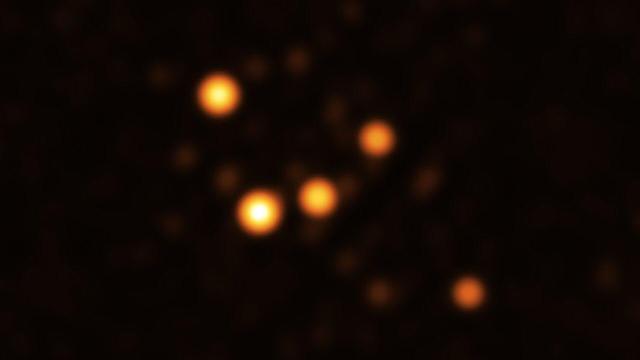By combining the light from four powerful telescopes, scientists have captured the deepest and clearest views yet of the immediate environment around the supermassive black hole at the centre of our galaxy.
“This really is the result of a decades-long effort to observe the Galactic Centre,” Julia Stadler, an astronomer at the Max Planck Institute for Astrophysics and the co-author of two new studies detailing the new observations, explained in an email.
The peer-reviewed papers were published today in Astronomy & Astrophysics, one detailing the new views of the black hole and the other a description of the way mass is distributed within the galactic core. This team, which includes Reinhard Genzel, director of the Max Planck Institute for Extraterrestrial Physics, is no stranger to Sagittarius A*, having won the 2020 Nobel Prize in Physics “for the discovery of a supermassive compact object at the centre of our galaxy.”
Using the European Southern Observatory’s Very Large Telescope Interferometer, the astronomers were able to track the movements of several stars around our galaxy’s supermassive black hole, known as Sagittarius A* (pronounced Sagittarius A-star). They even spotted a previously unknown star, now named S300. Equipped with the new data, the astronomers were able to test Einstein’s general theory of relativity, devise a new mass estimate for the black hole, and measure our distance to the Galactic Centre. They were also able to observe much more precisely how stars behave close to Sagittarius A*.

It takes these stars between 14 and 18 years to complete a full revolution of the black hole, requiring extended periods of observations to get accurate measurements of their orbits. The team, in addition to collecting many years of data, used the GRAVITY interferometer, which combines light gathered by all four 27-foot (8.2-metre) telescopes at ESO’s Very Large Telescope. GRAVITY boosted the “angular resolution by a factor of 20 in comparison to what was possible before,” as Stadler explained, saying this was an “enormous improvement.” This, plus the use of sophisticated imaging software, “allowed us to obtain the deepest high-resolution images of the Galactic Centre yet,” said Stadler.
GRAVITY measured precise movements of stars as they spun around the black hole from March to July 2021. Star SN29, which made its nearest approach of Sagittarius A* in May 2021, passed the black hole at a distance of 13 billion kilometres, which is roughly three times the distance from Pluto to the Sun. Star SN29 has a rotational velocity of 8,740 km per second, which boggles the imagination. That’s 0.03% the speed of light, and it surpasses the previous record-holder star, S2, which moves at 7,701 km per second. The discovery of S300 — the previously undetected star — shows that GRAVITY is good at finding even faint objects.
“We are really stunned by the number of stars we see so close to the black hole,” Stadler said. “To distinguish them from each and precisely track their motions [relative to each] other is really just possible due to the high resolution of GRAVITY.”
A revised estimate of the black hole’s mass was made possible by tracking the motions of the stars, revealing it to weigh as much as 4.3 million Suns. This observation was found to be consistent with Einstein’s theory of general relativity. The team “also used the measurements to see if there is some extended mass component surrounding Sagittarius A*, and we find that there can not be much additional mass,” Stadler explained. “For example, we can exclude that there is a swarm of 1,000 smaller black holes around Sagittarius A*.” Good to know. The data also allowed for the most precise measurement yet of its distance from Earth: 27,000 light-years.
GRAVITY will be upgraded later this decade, when it will become GRAVITY+, which, of course. It’ll still be installed on VLTI, where it will acquire even better views of the supermassive black hole. The hope is to spot stars even closer to Sagittarius A* and to measure the speed at which it rotates.
